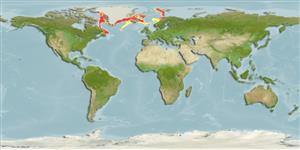Environment: milieu / climate zone / depth range / distribution range
पारिस्थितिकी
समुद्री बाथीड़िमरसल; गहराई सीमा 122 - 1450 m (Ref. 117245). Deep-water; 80°N - 50°N, 61°W - 18°E
North Atlantic: Nunavut, Davis Strait to the Greenland and Norwegian seas.
आकार / वज़न / Age
Maturity: Lm ? range ? - ? cm
Max length : 24.0 cm SL पुल्लिंग / अलिंग; (Ref. ); 22.2 cm SL (female)
Short description
आकृति विज्ञान | मौरफोमैटरिक्स
जानवरों की रीड़ का जोड़: 93 - 107. Mediolateral row of neuromasts present from above anus to caudal fin base. First dorsal fin pterygiophore associated with vertebra 4-5 (rarely 6). Eye large and circular; pupil diameter 2.1-3.6% SL. Nostril tubes short 0.4-1 % SL. Body color uniformly brownish, without crossbars. Predorsal area without scales. Head pores relatively large and not tube-shaped (Ref. 41107).
Life cycle and mating behavior
परिपक्व अवधि | पुनरुत्पत्ति | मछलीऔ का अंडे देना | अंडे | Fecundity | लार्वा
Møller, P.R., 2001. Redescription of the Lycodes pallidus species complex (Pisces, Zoarcidae), with a new species from the Arctic/North Atlantic Ocean. Copeia 2001(4):972-996. (Ref. 41107)
IUCN Red List Status (Ref. 130435)
Threat to humans
Harmless
Human uses
अधिक जानकारी
आम नामउपशब्दचपायचयपरभक्षीईकोटोकसीकोलौजीपुनरुत्पत्तिपरिपक्व अवधिमछलीऔ का अंडे देनाSpawning aggregationFecundityअंडेEgg development
Age/Sizeबाढ़Length-weightLength-lengthLength-frequenciesमौरफोमैटरिक्सआकृति विज्ञानलार्वालारवल गतिकीभर्तीबहुतायतBRUVS
संदर्भजलीयकृषिजलीयकृषि रूपरेखाखींचआनुवंशिकीElectrophoresesहैरेटिबिलटीबीमारीप्रक्रमणNutrientsMass conversion
सहयोगीयोतस्वीरेStamps, Coins Misc.ध्वनिसिगुयटिरारफ्तारतैरने के प्रकारगिल क्षेत्रOtolithsदिमागदृष्टि
साधन
Special reports
Download XML
इंटरनेट स्रोत
Estimates based on models
Preferred temperature (Ref.
123201): -0.4 - 4.6, mean 1.5 °C (based on 300 cells).
Phylogenetic diversity index (Ref.
82804): PD
50 = 0.5000 [Uniqueness, from 0.5 = low to 2.0 = high].
Bayesian length-weight: a=0.00120 (0.00057 - 0.00252), b=3.10 (2.91 - 3.29), in cm total length, based on LWR estimates for this (Sub)family-body shape (Ref.
93245).
Trophic level (Ref.
69278): 3.4 ±0.4 se; based on size and trophs of closest relatives
लौटाव (Ref.
120179): निम्न, न्यूनतम जनसंख्या दुगनी होने का समय 4.5 - 14 वर्ष। (Preliminary K or Fecundity.).
Fishing Vulnerability (Ref.
59153): Low vulnerability (19 of 100).
